
30 September 2013
Dear Family, Friends, and Colleagues,
Greetings from Antarctica! Our team traveled from our homes first to Christchurch, New Zealand, where we assembled and enjoyed the sunny weather and green gardens before our trip south. We had been told ahead to pack a "boomerang bag" which we would take with us if our flight to Antarctica was turned back en route by fast-changing Antarctic weather, because we would not get all our luggage back until we finally made it to Antarctica. (We found out that the record for consecutive boomerangs was seven!) We had also been told that certain items were required in our carry on bags, which had to fit under our seats. We thought these were one in the same so were quite relieved to be told during the pre-flight briefing the day before our flight that the boomerang bag was just one of our checked bags.
Our 5-hour flight from Christchurch to McMurdo was on a US Air Force C-17 transport. The flight was smooth (and noisy - we wore ear plugs), and the bag lunch they gave us enough for two. We got to take turns going into the cockpit to take photos of Antarctica from the aircraft. The landing was super-smooth and then, Wow!, we stepped out and found ourselves on this giant ice sheet in Antarctica, with a smoking Mt. Erebus in the background! The US Antarctic Program (USAP) staff took us in large polar transporters across the ice sheet and then around roads to the McMurdo base. On the way we saw penguins, seals, the New Zealand base, and more great bleak Antarctic scenery. We had a quick orientation briefing, were issued room keys and linens, told where to get food and our luggage, and given a schedule for a few events we'd want to attend.
The large USAP McMurdo base resembles a clean, well-run polar mining town with about 1000 residents. There are no commercial activities, but otherwise it has just about everything you'd expect: dorms, a cafeteria (serving a variety of hearty food), a small store, post office, coffee house, bar, labs, gyms, support buildings ad infinitum, lots of heavy equipment, warehouses, fuel tanks, etc. Impressive attention is paid to waste management, recycling, and environmental stewardship, making it one of the cleanest towns on earth. There is a port - open only a very short time each year, and that only after break-in by a heavy icebreaker - with a man-made pier made of reinforced ice. There are hiking trails and historic sites. We had a guided tour to Robert Scott's "Discovery Hut" from 1902, close by the base (seehttp://en.wikipedia.org/wiki/Discovery_Hut). While anyone can walk there, because we had a guide we were allowed inside, seven at a time. In the "freeze-dried" environment of Antarctica, everything down to animal carcasses awaiting skinning and boxes of supplies was just as it was, and is being left that way for the future.
Speaking of "freeze-dried", that's how we felt after walking back from the hut to the base into a stiff and very cold wind - evening air temperature had dropped to 5 degF - the term "wind chill" (in that case well below -20) was certainly appropriate! (In Christchurch the USAP issued us cold weather clothing, and we were glad we had it.) But for the most part temperatures have been in the teens, and today's 23 degF and light winds make it feel almost balmy. Our ship, the research icebreaker Nathaniel B. Palmer, arrived yesterday morning and fueling began immediately. (The McMurdo base reverts to its 200-person winter status this weekend and the fueling crew needed to get done so they could head home.) The departing science party will be off the ship this morning, and we board and begin loading right after lunch today.
There have been many little hiccups along the way, and one giant one: Much of our "do not freeze" cargo was inexplicably left sitting out in sub-freezing conditions, despite being correctly and unmistakably labeled as "Do Not Freeze". (There are procedures for this, beginning with a cargo plan before we even ship the items from our labs, and every group affected by this incredible blunder had followed instructions perfectly.) Even the ship's "do not freeze" food was sitting out in the cold. One container of our DNF cargo was correctly kept above freezing, and by some miracle that contained the standards for salinity and carbon, without which we would have had to cancel the expedition. But the Argo floats - worth $500,000 - were not so lucky, and must be shipped back, unused. (They would have provided the first winter CTD casts from much of this region.) We will not know the extent of damage to our other programs until we begin measurements, but we are hopeful that we can work around most problems.
We have a very good team for this cruise. I enjoy the way everyone gets along together and can tell already we will work together well as one team. I met the Captain last night, and was impressed in every respect. Our on-board Raytheon Polar Services Corporation support staff are a good bunch. So prospects are good for our upcoming voyage. Last night we all unwound in the bar, and in a few hours we begin loading. I'll report again when we leave port.
Best Regards,
Jim Swift
PS - Because I do not go onto the ship's very limited email (james.swift.guest@nbp.usap.gov) until tomorrow, I can send lots of photos today from the McMurdo base internet:
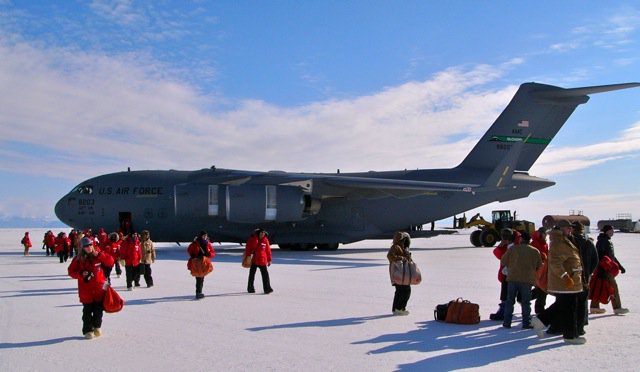 "exiting_C17_at_McMurdo.jpg" shows us exiting the C-17 on the ice shelf runway near McMurdo.
"exiting_C17_at_McMurdo.jpg" shows us exiting the C-17 on the ice shelf runway near McMurdo.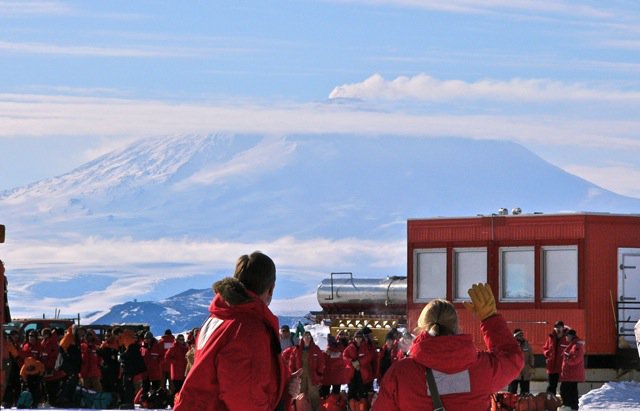 "MtErebus_telephoto_from_ice_runway.jpg" shows the smoking Mt. Erebus active volcano from the ice runway.
"MtErebus_telephoto_from_ice_runway.jpg" shows the smoking Mt. Erebus active volcano from the ice runway.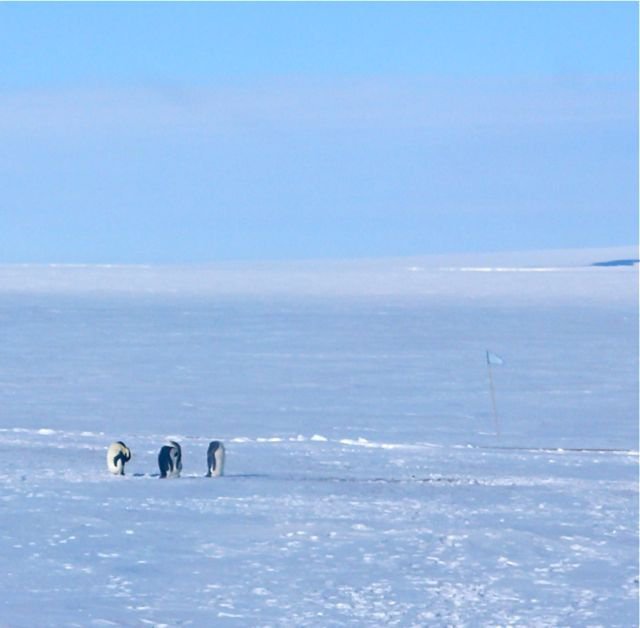 "penguins_on_ice_shelf.jpg" and "seals_on_ice_shelf.jpg" show Emperor penguins and Weddell seals seen through the windows of the polar transporter on our way from the ice shelf runway to the USAP McMurdo base.
"penguins_on_ice_shelf.jpg" and "seals_on_ice_shelf.jpg" show Emperor penguins and Weddell seals seen through the windows of the polar transporter on our way from the ice shelf runway to the USAP McMurdo base. "penguins_on_ice_shelf.jpg" and "seals_on_ice_shelf.jpg" show Emperor penguins and Weddell seals seen through the windows of the polar transporter on our way from the ice shelf runway to the USAP McMurdo base.
"penguins_on_ice_shelf.jpg" and "seals_on_ice_shelf.jpg" show Emperor penguins and Weddell seals seen through the windows of the polar transporter on our way from the ice shelf runway to the USAP McMurdo base. "supplies_inside_Scott_hut.jpg" and "carcasses_inside_Scott_hut.jpg" were taken during my tour of the Scott 1902 "Discovery" hut.
"supplies_inside_Scott_hut.jpg" and "carcasses_inside_Scott_hut.jpg" were taken during my tour of the Scott 1902 "Discovery" hut.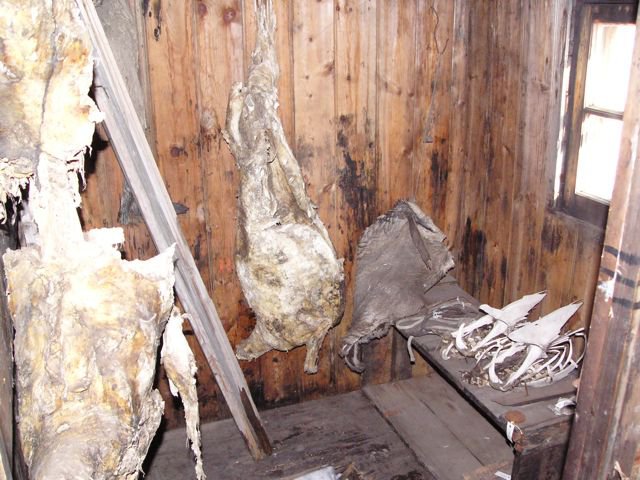 "supplies_inside_Scott_hut.jpg" and "carcasses_inside_Scott_hut.jpg" were taken during my tour of the Scott 1902 "Discovery" hut.
"supplies_inside_Scott_hut.jpg" and "carcasses_inside_Scott_hut.jpg" were taken during my tour of the Scott 1902 "Discovery" hut.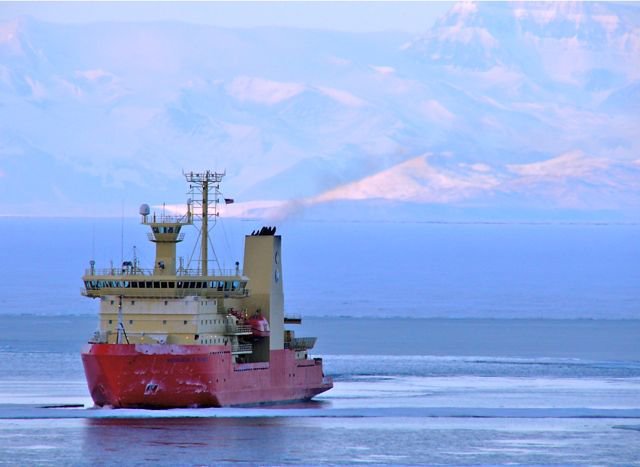 "Palmer_arriving_at_McMurdo.jpg" shows the ship turning toward the base, with a backdrop of bleak Antarctic mountains.
"Palmer_arriving_at_McMurdo.jpg" shows the ship turning toward the base, with a backdrop of bleak Antarctic mountains. "NBP_and_McMurdo.jpg" shows the Scott "Discovery" hut in the foreground, the Nathaniel B. Palmer at the ice pier, and the McMurdo base behind. The row of tan and brown buildings just above and to the right of the ship in the photo are the main dorms, and
"NBP_and_McMurdo.jpg" shows the Scott "Discovery" hut in the foreground, the Nathaniel B. Palmer at the ice pier, and the McMurdo base behind. The row of tan and brown buildings just above and to the right of the ship in the photo are the main dorms, and